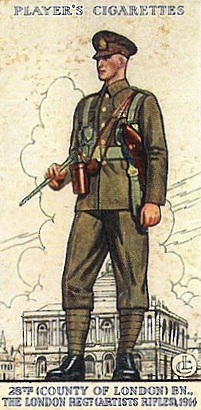ARTISTS RIFLES
The Artists Rifles Regiment was formed in 1859 by art student Edward Starling. It was a volunteer regiment and formed out of the widespread fear of a French invasion. Many of those who joined were artists, actors, musicians, and architects and its first headquarters was located at Burlington House in London. Its first commanders were the painters Henry Wyndham Phillips (1820–1868) and Frederic Leighton (1830-1896). Creativity and beauty were at the core of the Artists Rifles, which may seem an odd combination for an army regiment, but one can see both qualities even in the regimental cap badge. Other renowned artists also joined the regiment in its early period, such as John Everett Millais (1829–1896), George Frederick Watts )1817-1904) and William Morris (1834–1896), but the Artists Rifles were a fighting, active regiment and saw action in the Boer War and after some reorganisation it became the 28th (County of London) Battalion on 1st April 1908. The First World War would see the regiment leading from the front as they become a training regiment for officers in this period. It is also for this reason that the Artists Rifles had one of the highest casualty rates of any regiment. Members of the regiment would be awarded eight Victoria Cross's and over 850 other military awards including 52 Distinguished Service Order's and 822 Military Cross's and were mentioned in dispatches 564 times. After the First World War, the Artists Rifles were active as a training regiment in the Second World War, had links with the Special Air Service and become a unit of the Territorial Army in 1967. Suffolk artists associated with the Artists Rifles include Felix Emile Andrews, John Nash, William Palmer Robins, Robert Borlase Smart, Arthur Reginald Smith and Frederick Boyd Waters.
Works by This Artist

|
|